SUBJECTS
GRADE
Show Results
The Day the Crayons Quit and Came Home
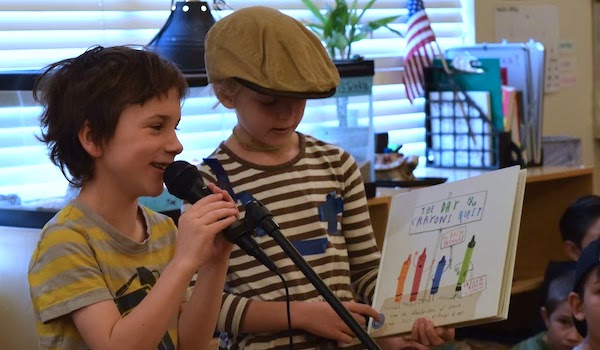
Lesson Summary
- Create a reader’s theatre version of the books The Day the Crayons Quit and The Day the Crayons Came Home by Drew Daywalt.
- Write out a crayon’s letter and learn to address an envelope.
Lesson Plan and Procedure
Lesson Key Facts
- Grade(s): 2, 3
- Subject(s): Drama, English Language Arts
- Duration of lesson: Three sessions, 30 minutes each
- Author(s): Haley Flanders
Preparation
This lesson can be extended into multiple days and weeks. Make sure you have the books and other materials. Type up the books’ text and cut it into separate roles. (The Day the Crayons Quit has a typed script available in a PDF under “Additional Resources.”)
Warm-Up/Hook
Read both these books to your class: The Day the Crayons Quit and The Day the Crayons Came Home, written by Drew Daywalt and illustrated by Oliver Jeffers.

Reflection
Teacher: Let’s talk about the two books we just read. Which color of crayons did you like best? Why? How did they feel towards Duncan? Why did they feel that way? How do the two books differ from one another? How are they similar?
Take note of what characters the children liked for future casting purposes. Then introduce the concepts of plot, conflict, and comparison.
Teacher: The plot of a story is the sequence of events that happen. It answers questions like who, what, when, where, why, and how. Let’s discuss the book by answering these questions: Who is the book about? Where are the crayons? What do they want from Duncan? When did these events happen? Why are they upset? How do they try to fix their problems?
Have the students share their answers. Perhaps write down what they say on the board. Then summarize the plot again, as shown below.
Teacher: The crayons are upset at the way their owner has been treating them, and they are writing him letters, asking him to treat them better. Their letters are also examples of persuasive writing. They are working together to try and persuade, or convince, Duncan to take better care of them and look out for their safety. In stories, not everything is always happy. They have conflicts, problems, and challenges. Then the characters have to respond to these challenges. Most of the crayons are upset with Duncan. Can you name one crayon and describe the conflict that crayon has towards Duncan? As we share, let us compare the different conflicts in the plot that the crayons face.
Introduction
Teacher: We are going to be putting together a reader’s theatre performance of these two books. Each of you will be assigned a crayon or a narrator role. You will write out your letter or narration from the book in the color of your character’s crayon. Then you will learn how to properly fill out an envelope, as if you are mailing your letter to the school from your home. Finally we will dress up in the color of your crayon and perform the book for an audience. Let’s first figure out what our roles will be.
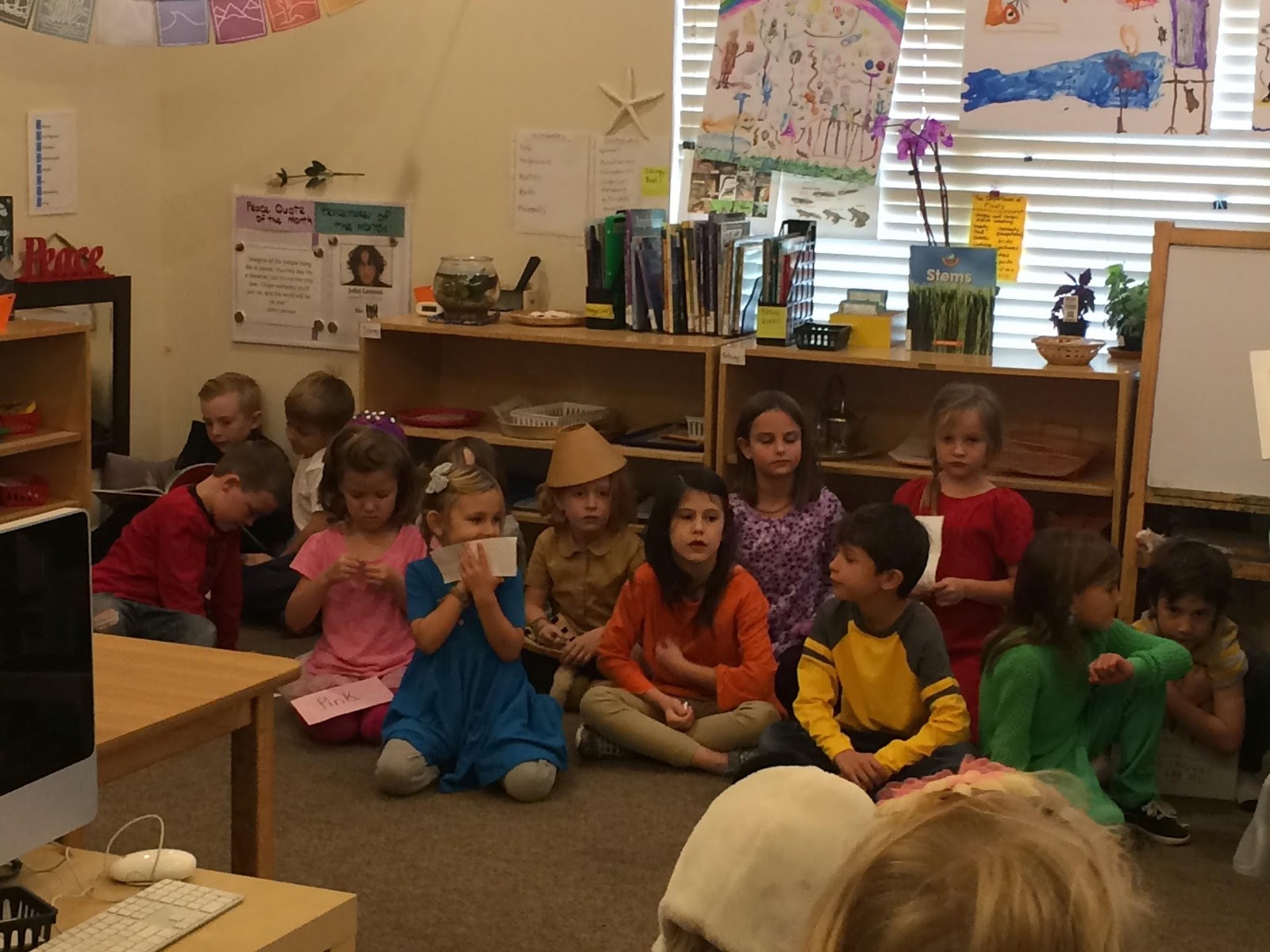
Assign each student a crayon or narrator role (one narrator per book). If you do not have enough students, you can skip crayons. If you have more, you can assign more than one student the same crayon, and they will each read it. You can consider the role of narrator to be the character Duncan, if you like. The books have the following 25 roles:
The Day the Crayons Quit: Narrator, Red, Purple, Beige, Gray, White, Black, Green, Yellow, Orange, Blue, Pink, Peach
The Day the Crayons Came Home: Narrator, Maroon, Pea Green (Esteban the Magnificent), Neon Red, Yellow, Orange, Tan (Burnt Sienna), Glow in the Dark, Gold, Turquoise, Big Chunky Toddler, Brown
Instruction/Rehearsal
Teacher: Now you are going to write your part from the books, using your own paper and the color of crayon that matches your character. Narrators, you may use a pencil or pick any color you like. I want you to notice that many of you have the same words or phrases in your letters, even the same methods of persuasion. This helps to give the book a theme, a pattern, and even a rhythm. What words or subjects do you see in your letter that you also see in others’ letters? Why do you think the author (Drew Daywalt) chose to create this type of repetition throughout his book?
Give each student a typed version of his or her letter or narration (so they do not all have to share the book), based on the roles you assigned. Have them copy it on a piece of paper, using the color of their crayon. Note: Lighter crayons (White, Yellow, Glow in the Dark) may need to write on black paper for the writing to show up.
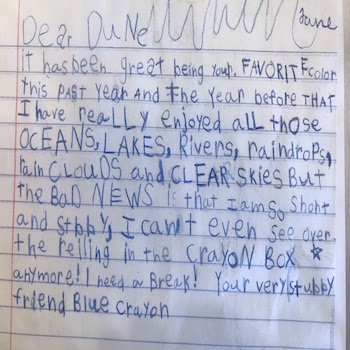
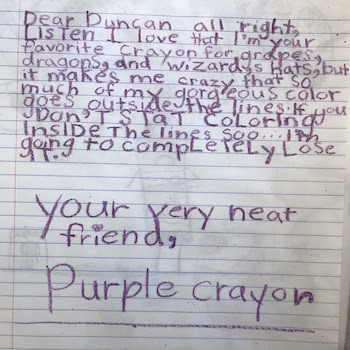
Teacher: Now, just as the crayons wrote, compiled, and sometimes even mailed these letters to Duncan, we are going to learn how to fill out the outside of an envelope so that we can mail letters to people in the future.
Hand each student a copy of the school’s name and address and their own name and home address. Hand them an envelope and a fake stamp outline (proper size) to design. Hand them coloring materials, scissors, and glue.
Teacher: To fill out an envelope, we must put a stamp in the top right corner because that is how we pay the mailman for the shipment. We buy stamps and then stick them on the envelope. Now write the school’s address in the center of the envelope, nice and big, so that the mailman can easily tell who is receiving this letter and where that person lives. Let’s ship it to the school. Now let’s look at our own addresses on the paper I passed out. Write your name and address in the top left corner, so the mailman and the receiver know who is sending the letter. This is also important so that the mailman can send it back if the school address is written incorrectly. Now let’s fold up our letter and put it inside. Let’s seal up the envelope and take our letter home.
Provide them with wet paper towels to seal their envelopes, or help them pull off the labels of any sticker envelopes. Addresses are private information, so do not display these in your classroom. Yet you can choose to have the children take their envelopes home after the play and use them as props or set dressing for the reader’s theatre. You can also choose to have them put their written letters in a binder as a book for the classroom, instead of having them put it in the envelope.
Activity/Performance
Teacher: Now, with the typed version of your script, I want you to practice reading your lines. You can take this home and memorize it, or you can read from it on the day of the performance.
Give the children days or weeks to practice. To help them develop their characters through body movement, gesture, voice, and facial expression, have them move around to characterized music and act like their characters. They can focus on changing their posture by leading with one body part, taking up a little or a lot of space as they walk and talk, using their hands to emote, etc. Have them watch cartoons and study the voices (pitch, intonation, and speed) of similar characters. Ask them to show anger, frustration, or happiness in their faces while looking in the mirror or copying a friend. Have them come to class in costume before the performance day to see if that helps them get into character.

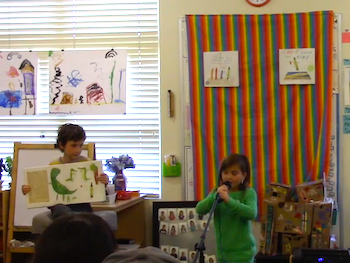
On an assigned day, have the students dress in the color of their crayons and perform the story in order in front of an audience, with the narrator sitting in a chair at the front and holding up the book to the correct page as the pages are read.
Conclusion
Teacher: Now that you have told the story in front of an audience, let’s review the plot. What happened at the beginning of each of these books? What happened at the end? How did they work together to solve their problems? Now let’s talk about the activities. What did you like about them? What was challenging? What was it like to portray a character in a book and convey the conflict and the rest of the plot? How were your characters different? What did you learn from this activity?
Extension Activities:
Have the students each paint or color a picture of his or her crayon, perhaps a picture that matches the illustration in the book. Display them as set dressings during the performance (refer to image 8).

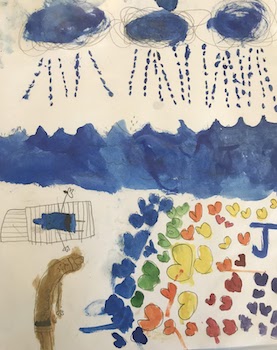
Have the students design and paint the cardboard box castle featured at the end of The Day the Crayons Came Home (refer to image 11 and the background in image 8).

Learning Objectives
- Demonstrate understanding of key details in a text.
- Describe how text supplies rhythm and meaning in a story/song.
- Describe the overall structure of a story.
- Compare and contrast multiple versions of the same story.
- Read orally with appropriate expression and accuracy.
- Demonstrate understanding of English grammar when writing and speaking.
- Develop imagination.
- Define roles and work in a group.
- Communicate character through physicality and voice.
- Identify elements of dramatic structure.
- Perform for classmates or another audience.
Utah State Board of Education Standards
This lesson can be used to meet standards in many grades and subject areas. We will highlight one grade’s standards to give an example of application.
Grade 2 English Language Arts
Standard 2.R.5: Ask and answer questions such as who, what, where, when, why, and how to demonstrate understanding of key details in a text. (RL & RI)
Standard 2.R.7: Describe how characters respond to major events and challenges. (RL)
Standard 2.R.10: Describe the overall literary and informational text structure to locate facts, details, and information efficiently. (RL & RI)
Standard 2.R.14: Compare two or more versions of the same text from different cultures and the most important points presented by two texts on the same topic. (RL & RI)
Standard 2.R.4: Read grade-level text* with accuracy and fluency to support comprehension. (RL & RI)
Grade 2 Drama
Standard 2.T.CR.4: Define roles and responsibilities and participate in group decision making.
Standard 2.T.CR.5: Create character through physical movement, gesture, sound and/or speech and facial expression.
Standard 2.T.P.1: Identify the character, setting, and essential events (plot) in a story that make up the dramatic structure, and use choices to shape believable and sustainable drama/theatre work.
Standard 2.T.P.2: Demonstrate the ability to work effectively alone and cooperatively, with a partner or in an ensemble.
Standard 2.T.P.4: Use body to communicate meaning through space, shape, energy, and gesture.
Standard 2.T.P.9: Share dramatic play and guided drama experiences within the classroom or with invited guests.
Equipment and Materials Needed
- Lined paper
- Crayons/colored pencils of each color in the books
- Envelopes and fake stamps
- Student and school addresses
- Scissors
- Glue
- Pencils
- Daywalt, Drew. The Day the Crayons Quit. London: Philomel Books, 2013.
- Daywalt, Drew. The Day the Crayons Came Home. London: HarperCollins Children's Books, 2017.
Additional Resources
- Two simpler versions of the books are The Crayons’ Book of Colors and The Crayons’ Book of Numbers. These are meant for early childhood ages and are not sequels to the books. They do not contain letters like the original books do.
- To save time, here is a typed version of The Day the Crayons Quit: https://texasbluebonnetaward2015.files.wordpress.com/2014/02/rtdaythecrayonsquit.pdf
- Script for both books in PDF format
- For more fun ideas, worksheets, and activities based on the books, visit their website: http://www.crayonspicturebooks.com/
Image References
Images 1–10: Haley Flanders

www.education.byu.edu/arts/lessons
 Download
Download